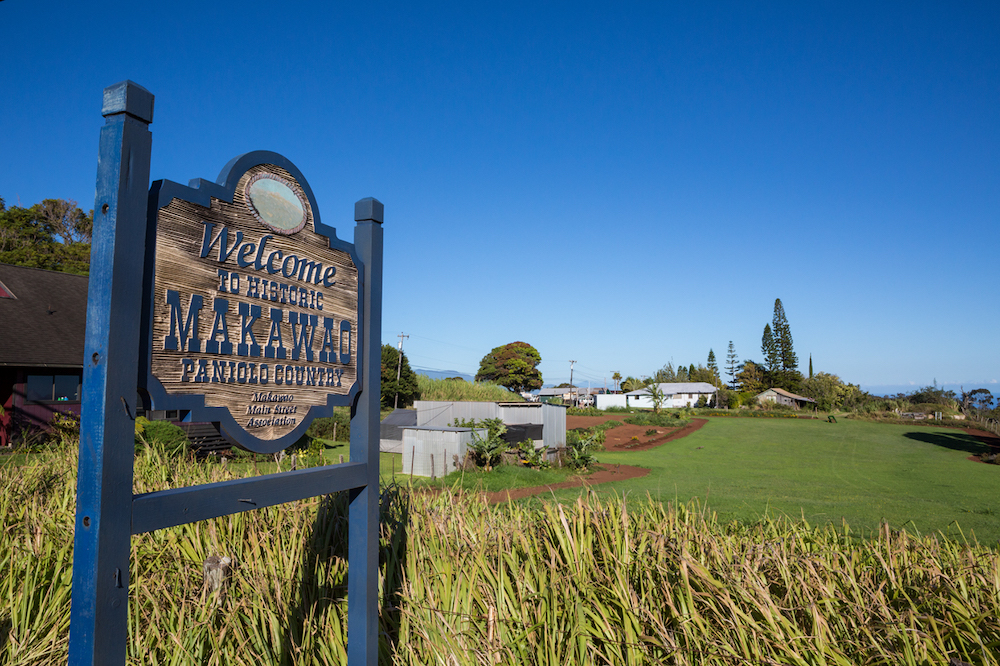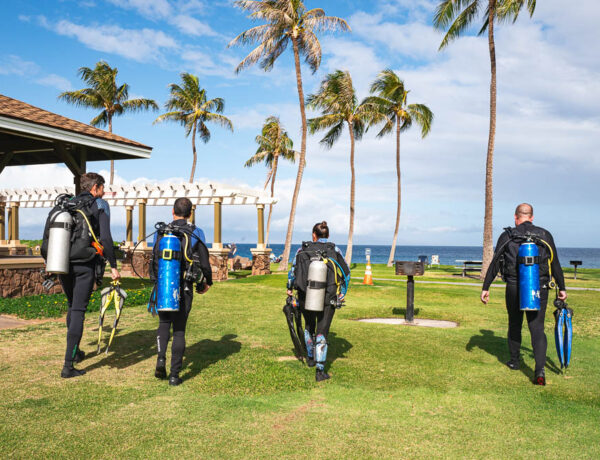If you’re looking for an unforgettable outdoor experience on Maui, consider backpacking into one of Haleakala National Park’s two wilderness tent campsites.
Imagine waking up to a cool, foggy mist with an enamel coffee cup in hand, enjoying the utter stillness that surrounds you. Peeking from behind the mist, a geological outcropping looms over the grassy valley where you’ve staked your tent. Nēnē birds waddle past, softly honking as they search for breakfast.
This is Maui as few tourists experience it.

This post contains affiliate links. By purchasing through these links, we may receive a small commission at no additional cost to you. Maui Trip Guide is also a participant in the Amazon.com Associates Program. As an Amazon Associate, we earn from qualifying purchases.
Nestled in the grasslands and surrounded by stunning volcano outcroppings, Haleakala’s wilderness campsites offer a serene and peaceful escape from the heavily trafficked tourist areas on Maui.

Please note that these campsites are recommended for experienced campers who are in good physical shape and have some prior outdoor experience. Advance planning and proper supplies are also necessary for a successful trip.
For those who are up for the adventure, an overnight stay at one of these campsites offers a unique and off-the-beaten-path experience that few tourists discover while on the Valley Isle.
In this post:
- Wilderness hike-in camping at the Haleakala crater
- Do you need a permit to camp at Haleakala?
- About Haleakala’s Holua campsites
- About Haleakala’s Paliku campsites
- What to expect when you camp at Holua or Paliku
- What to pack for wilderness tent camping at Haleakala
- Tips for wilderness camping at Haleakala National Park
- What else you can do while at Haleakala National Park
Wilderness hike-in camping at the Haleakala crater

Maui’s diverse ecosystem includes more than beaches and palm trees. Haleakala National Park boasts rain forests, grasslands, and its crown jewel — stretching two miles skyward, the crater at Haleakala National Park.
Along with hiking the crater trails, visitors can opt for an immersive volcano experience by camping at Haleakala’s backcountry tent sites.
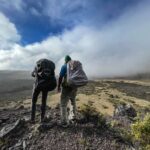
Read more about our trail hike to the Hōlua campground, and our hike out via Halemau’u Trail:
There are two wilderness campsites at Haleakala National Park. Both must be accessed via hiking trail:
- Hōlua, which lies in the valley near the steep Halemau’u Trail, and
- Palikū, a campsite on the eastern side of valley, near a rainforest cliff

What we liked about backcountry camping at Haleakala:
- Access to the coveted Haleakala sunrise
- The unique, off-the-beaten-path outdoor experience on Maui that most tourists don’t get to experience
- Stunning scenery — from volcanic sand dunes to geological formations among the crater valley — both on the trail and at the wilderness campsites
- Peaceful solitude and quiet while cultivating a connection with the land
- Wilderness encounter with the resident nēnē geese, Hawaii’s state bird
Challenges:
- These campsites have limited facilities, so you’ll need to be self-sufficient and bring all of your own gear If you’re flying in, that means checking your gear with the airline
- Considered primitive campsites – no potable water and outhouse style toilets
- The round trip hike is moderately strenuous due to the elevation gain when hiking out of the crater valley — especially when carrying gear

Do you need a permit to camp at Haleakala?
To camp at Haleakala, you’ll need to obtain a permit in advance. For the wilderness tent sites, you can make a reservation up to six months in advance. The cost is $8 if you book online, or $9 if you reserve by phone. As of 2023, only advance reservations are accepted.
About Haleakala’s Hōlua Campsites

Of Haleakala’s two hike-in campsites, the trek to Hōlua is shorter. You have two trail options to access the grassland terrain campsite. Hike the shorter, yet steeper 3.7 miles down Halemau’u Trail from the trailhead parking lot. Or choose the more gradual 7.4-mile one-way hike from the Keoneheʻeheʻe (also known as Sliding Sands) Trailhead.

In this wilderness campsite, specific tent areas aren’t clearly defined. Despite the campsite map and brown stakes at each site, we struggled to identify the boundaries of each campsite. After traipsing about the grassland, we eventually settled on the space we thought was ours.
On the night of our trip, only three other campsites were occupied (two of which were occupied by hikers in our party) — so we didn’t stress about it too much.

Near the tent campsites, you’ll find a cabin (also available by advance reservation) and two pit toilets (one near the tent sites and the other near the cabin). The cabin area also features a picnic table with bench seats. A nearby hitching bar allows for securing horses or other pack animals.
About Haleakala’s Palikū Campsites

The Palikū tent site requires a longer, more strenuous hike than to Hōlua — 9.3 miles from the visitor center or 10.4 miles from the Halemau’u Trailhead.
This distant wilderness site is located on the eastern side of the crater valley, farther from the park’s visitor center than Hōlua and closer to the rain forest microclimate.

As such, the weather at Palikū tends to lean toward cooler and rainier conditions than other parts of the crater.
Similar to the Hōlua campsite, the tent sites are nestled in a grassy valley. There’s also a pit toilet and seasonal access to non-potable water.
What to expect when you camp at Hōlua or Palikū
Compared to other attractions on Maui, you can expect a desolate experience at Haleakala’s campsites. The closer you are to Haleakala’s visitor center, the more people you can expect to encounter on the trail.

Silence
As you may expect, both wilderness campsites are remote and isolated. Haleakala has been described as the quietest place on earth. If you’re looking for the ultimate escape from raucous noise, camping at Hōlua or Palikū is sure to deliver.
Wildlife

Birds are the most sighted wildlife that call the Haleakala crater home. The most notable you’ll find at Haleakala’s wilderness campsites are nēnē birds — resident geese that are also Hawaii’s state bird. The nēnē we encountered at our campsite were obviously accustomed to human company. They traipsed through our campsite on several occasions, seeking the wayward morsel.
Just take care not to startle them. As we were searching for our tent site, I surprised one nēnē who saw my sudden appearance as a threat. The goose charged toward me — and I hastily retreated.
Chilly (and sometimes wet) weather
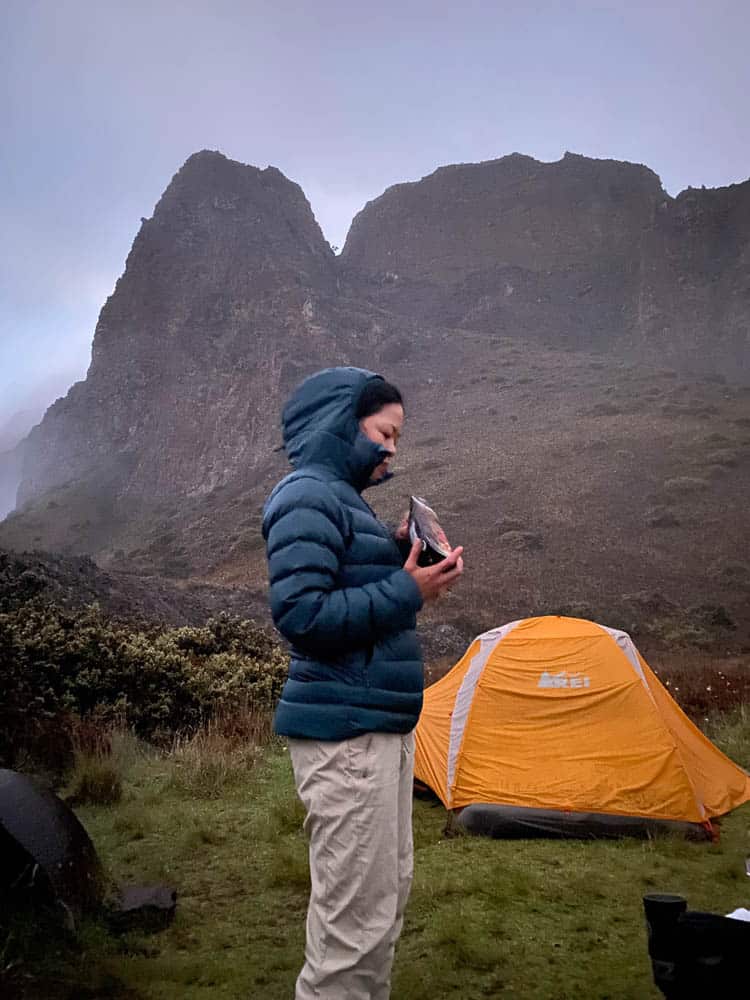
The microclimate at Haleakala differs vastly from the touristy West Maui and South Maui regions. Expect a much cooler environment, particularly when the sun disappears for the night. We came prepared with down-filled jackets, multiple clothing layers, beanies, and gloves.
Primitive facilities
Both campsites are equipped with pit toilets, which are about as delightful as the name would suggest. The less-than-fragrant structures provide privacy but aren’t terribly comfortable. One plus: the pit toilet I used at Hōlua had toilet paper, which I saw as a big plus — as far as primitive privies go.
Access to a coveted Haleakala sunrise spot — no additional reservation required
Along with your backpacking permit, you have access to one of Maui’s ungettable gets — sunrise at Haleakala. Reservations to nature’s stunning daybreak display typically sell out in minutes. But with a camping reservation, you have access to the park in the wee hours, before droves of rental cars and tour vans begin their journey up Haleakala’s access road.
The catch? You’ll have to set an early morning alarm. Then trek up to the visitor center via the Keoneheʻeheʻe (sliding sands) Trail under cover of night and starlight to experience sunrise from the summit.
What to pack for wilderness tent camping at Haleakala
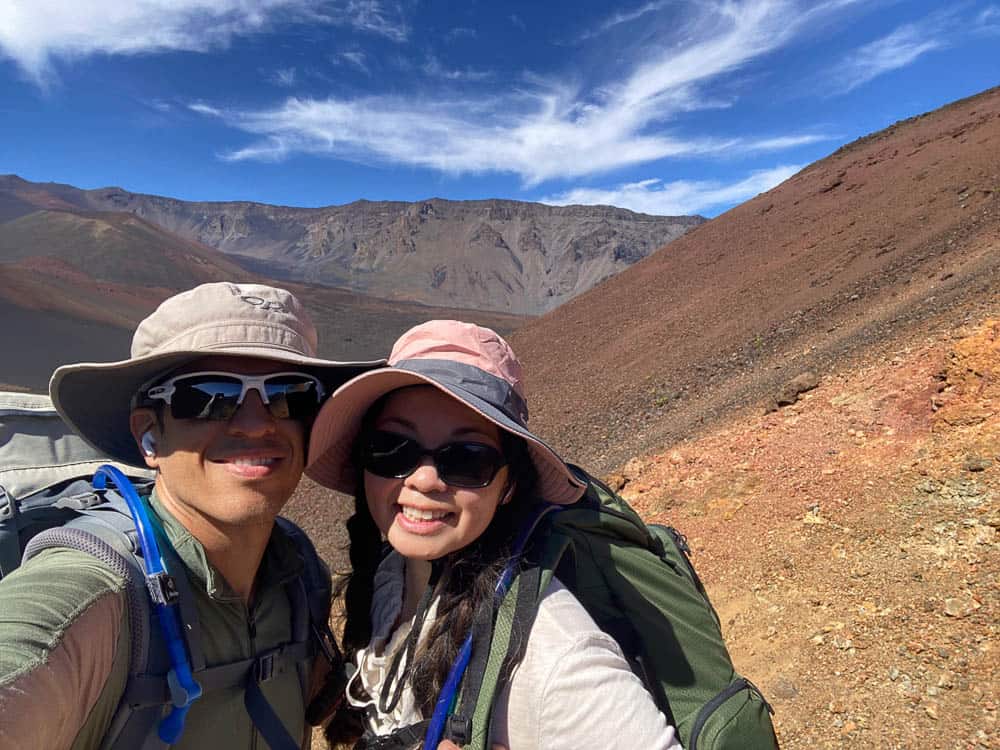
Because of the campsites’ remote locations, you’ll have to bring all of your gear and essentials with you — including food.
A limited amount of non-potable water (must be treated for drinking) may be available at each site. However, water isn’t available during drought seasons. We recommend always bringing your own water.

Essential camping gear:
- Reef-safe sunscreen
- Hat and sunglasses
- Large, sturdy hiking pack. We use a Deuter pack similar to this trekking backpack.
- Lightweight tent with rain flap and stakes
- Sleeping bag suitable for cold weather – The National Park Service states that temperatures at the summit can range from below freezing to 65 degrees Fahrenheit. However, wind chill and damp conditions can make temperatures feel colder than what’s recorded.
- Jetboil camping stove and fuel. Heat up water for cooking, or boil non-potable water for drinking. Camping fuel may be hard to come by (and obviously you can’t fly to the island with it in your luggage), so look for fuel early. We picked up ours at Adventure Sports in Kahului. Other stores on Maui that may carry camping fuel: Ace Hardware and Target.
- First aid kit
- Inflatable sleeping pad
- Headlamp
- Food — This brand of dehydrated pouch meals is our favorite. Especially the Biscuits and Gravy.
- Eating utensils. A friend introduced us to this long-handled spork, and it’s a game changer when eating a pouch meal.
- Drinking water. We use this lightweight water bladder.
- Solid hiking shoes
- Extra clothing layers
- Beanie
- Poncho
- Compostable toilet paper
Not absolutely essential, but these luxuries are nice to have:

- Garmin inReach Mini 2 handheld satellite communicator. This little device could literally be a lifesaver if someone becomes sick or injured while hiking Haleakala.
- Slide sandals to give tired feet a break from hiking shoes
- Tiny portable air pump to quickly fill your air mattress
- Water filter such as a LifeStraw
- Biodegradable wet wipes
- Lightweight camping chair
Tips for wilderness camping at Haleakala National Park

- If you’re flying to Maui, check in your hiking pack with the airline. We squeezed our packed hiking bag inside of this large waterproof duffel to protect our gear from rips and punctures.
- Pets aren’t allowed on the trails, so keep them at home if you plan to camp at Haleakala.
- Take it slowly when you start your hike. It took time for me to acclimate to the lower oxygen levels at the higher altitude.
- If you’re bringing a pocket stove, buy camping fuel as soon as you’re on the island. The portable tanks can be tough to find on Maui. Look for camping fuel at Adventure Sport, Ace Hardware, and Target.
What else you can do while at Haleakala National Park

If a backpacking trip isn’t your thing, there are plenty of things you can do on a day trip to Haleakala National Park. These are some of our recommendations:
- Take a guided tour
- Venture out on a day hike
- Camp at a drive-up tent site, such as Hosmer Grove
- Explore the visitor’s center
- Watch the sunrise (reservations required if you don’t have an overnight permit) or sunset from the summit
While you’re at Haleakala…
There are plenty of places to explore in Maui’s Upcountry. Check out our post 10 Things to do in Maui’s Upcountry: From Farm Tours to Small Town Shops
